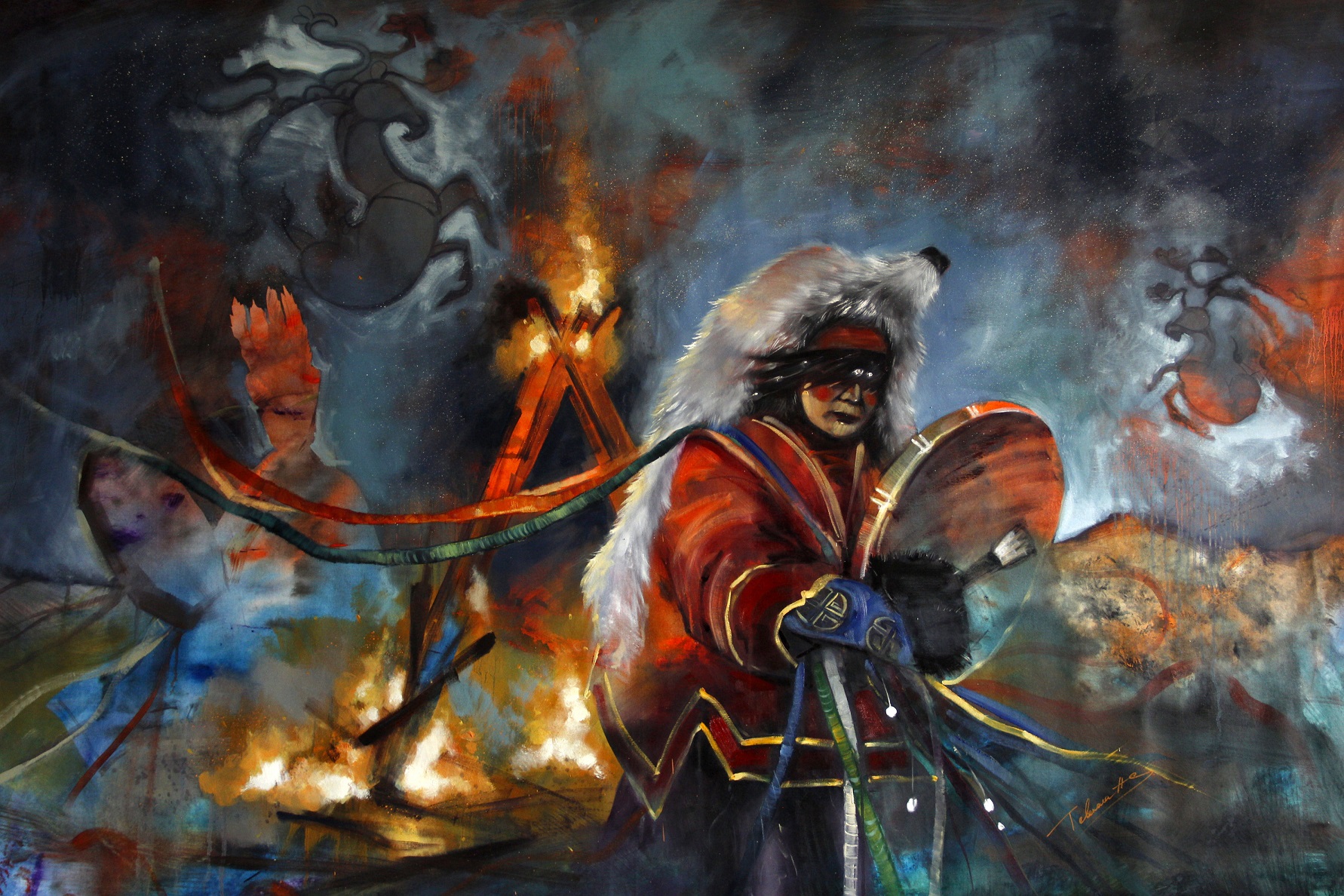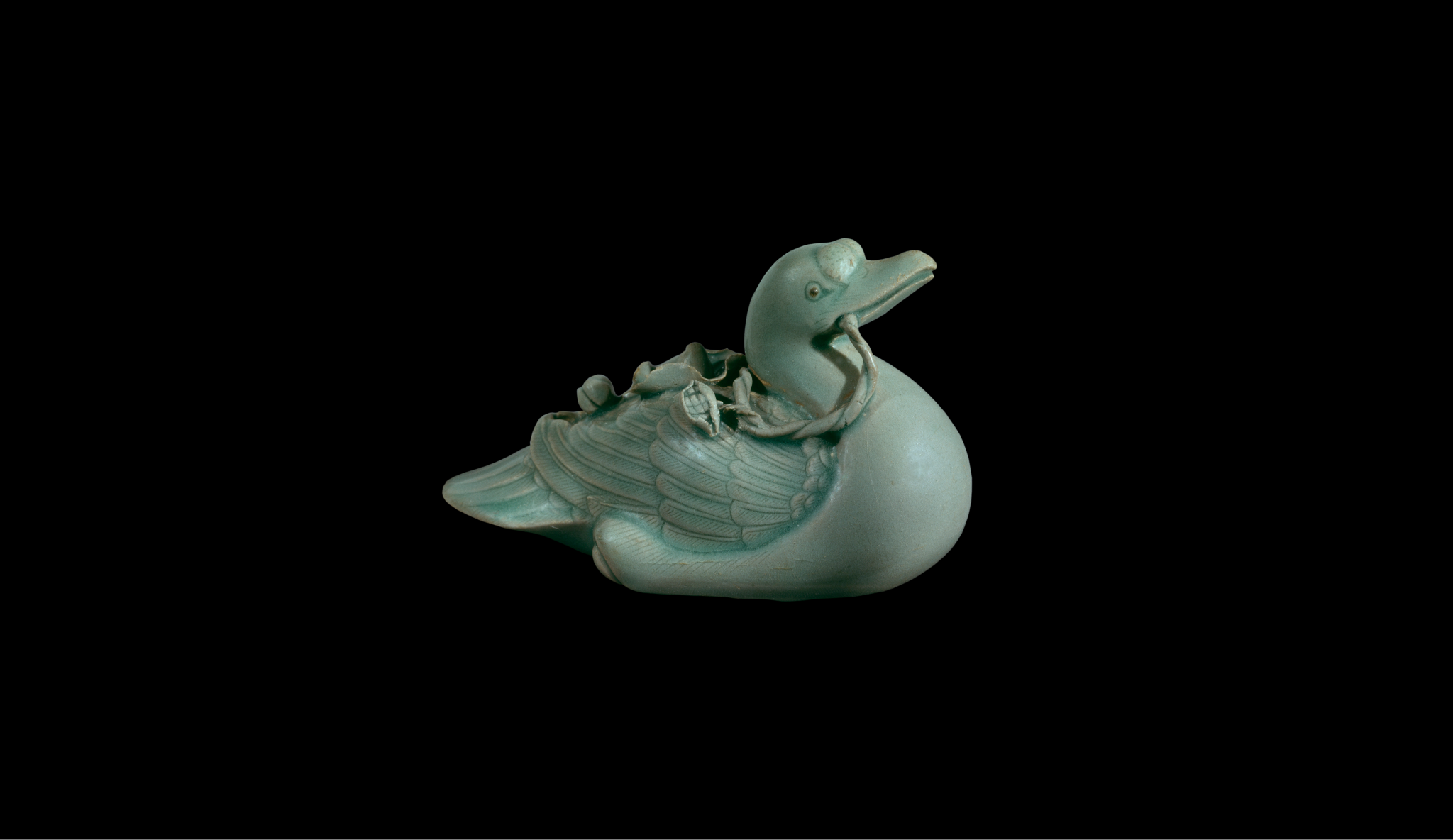
“Shadows of Hope” Installation view/Aspan gallery
The Aspan Gallery in Almaty is showcasing Ümıt Şuağy, an exhibition by Gulnur Mukazhanova, one of Kazakhstan's most renowned contemporary artists. Her works have been exhibited in many countries including Germany, the USA, the UK, France, and Russia, and in 2007, they were presented at the 52nd Venice Biennale. The exhibition in Almaty features a single, large-scale piece, a canvas more than 41 meters long. The media had translated the word ‘şuağy’ as ‘light’ or ‘ray’. However, Mukazhanova herself calls the work The Shadow of Hope, hinting at a much less ‘optimistic’ exhibition.
Since 2008, Gulnur Mukazhanova has been living in Berlin but still maintains a close connection with her homeland. Her work contains numerous references to the traditions of Central Asia, often focusing on the sociocultural and political situations in modern Kazakhstan. Mukazhanova embodies both citizenship and patriotism: on the one hand, she cares deeply about her country, and on the other, she is unafraid to speak up about its issues and seek solutions. Ümıt Şuağy is no exception. In this installation that runs until 22 September 2024, the artist reflects on Kazakhstan's social life in the post-Soviet years. Qalam dwells on Gulnur Mukazhanova’s art, her ideas, and the exhibition itself.

Gulnur Mukazhanova and her artworks from Post-Nomadic Reality series, 2021/Aspan gallery
‘After Seeing the Biennale, I Realized That I Had Literally Nothing.’
Gulnur Mukazhanova was born in 1984 in Semipalatinsk (Semey), but she spent her childhood in the village of Aksu-Aiuly (the center of the Shetsky district) near Karaganda. Gulnur recalls that when she was about five years old, her older cousin, who was passionate about art and later became a well-known artist herself, came to visit during the holidays. They spent a lot of time drawing together, and this sparked a serious interest in art for Gulnur, which eventually led her to study at the Department of Fine Arts at the Karaganda Buketov University. However, after her first year, Gulnur transferred to the Zhurgenov Academy of Arts in Almaty, where she studied applied arts and carpet weaving. Her cousin actively supported this decision and helped her settle into the new city.
Over time, Gulnur became acquainted with prominent local artists involved in contemporary art, such as Elena and Viktor Vorobyev, Erbossyn Meldibekov, Saule Suleimenova, Eduard Kazaryan, Zitta Sultanbayeva, and others, who are now well-known. Gulnur recalls that the Soros Center for Contemporary Art (SCCA Almaty), which was active from 1998 to 2010, was a hub for the art community. Important exhibitions were held there, and it had a solid educational program. Their events provided many opportunities for young artists to engage and interact with their more experienced peers. In this relatively small circle, Gulnur began to master the specific language of contemporary art, something she could not really have learned at the academy.
The year 2007 was a turning point in Gulnur Mukazhanova's career. Yuliya Sorokina, a well-known curator, invited the young artist who had little experience at the time to participate in the 52nd Venice Biennale. ‘When you find yourself in Europe for the first time, and immediately at the Biennale, in Venice … It was a shock. I had absolutely no understanding of where I had ended up,’ Mukazhanova recalls. ‘After seeing the Biennale for the first time, I realized that what I had was literally nothing, and that I needed to keep developing and making art. That's when I started thinking about continuing my studies in Europe. My sister and I went to Berlin, where I met people who helped me understand the educational system there. At the time, I thought I would go into textile design or fashion. After returning home, I began preparing for the exams and started learning German.’

Gulnur Mukazhanova. Postnomadic Reality #3, 2014. Installation, felt and mixed media. Height: 65 cm/Aspan gallery
‘For Me, Abstraction Is Associated with the Vastness of the Kazakh Steppe.’
Gulnur moved to the German capital in 2008 and soon graduated from the Weissensee Academy of Art. By the end of her studies abroad, she was focussing on working with felt, a material traditionally used by Central Asian nomads to make carpets, clothing, and yurts. Gulnur draws inspiration from her national traditions but also demonstrates that tradition can only endure through evolution through her art. Reviving the past is impossible, but it can be reinterpreted and seamlessly integrated into a new context. This is what the artist does by bringing felt into contemporary art. Gulnur Mukazhanova explains that the patterns on carpets were not merely decorative but a way of understanding reality. She doesn’t engage in stylization; instead, she uses felt to express modernity in a way that aligns with its traditional essence.
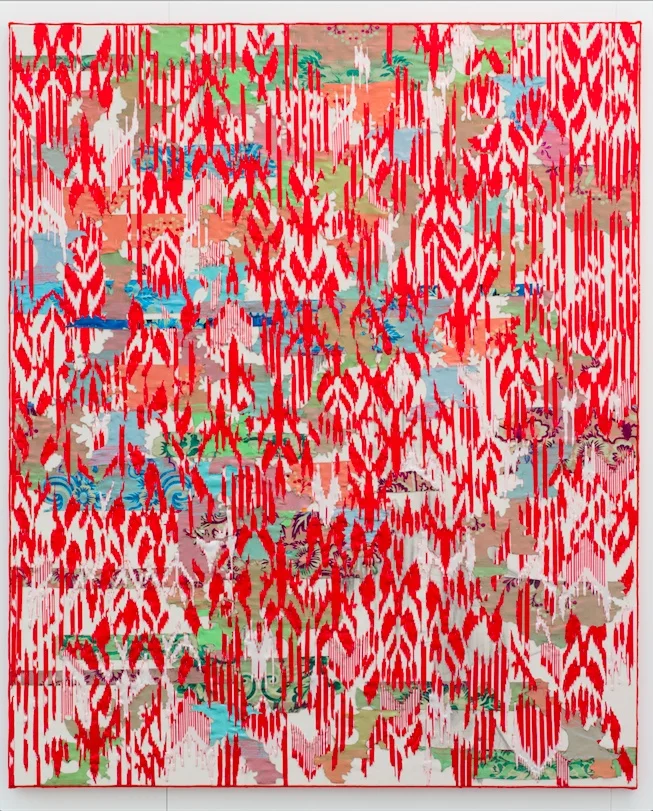
Gulnur Mukazhanova. The Moment of the Present, 2018 Velvet, brocade, lurex and pins/Aspan gallery
Gulnur wasn’t the first to ‘combine’ felt with contemporary art. One of the most prominent artists of the mid- and late-twentieth century, German Joseph Beuys (1921–86), also actively used felt, imbuing it with symbolic meaning. ‘For Beuys, felt was secondary, but I “grew up” in it. It's part of my life,’ explains Mukazhanova. Nevertheless, Beuys is an artist who has influenced her. Her list also includes Gustav Klimt (1862–1918), whose color combinations will likely remind visitors of Ümıt Şuağy. Other names include the father of abstraction, Wassily Kandinsky (1866–1944), American abstract painters Mark Rothko (1903–70), Barnett Newman (1905–70), Helen Frankenthaler (1928–2011), and the German artist Gerhard Richter (b. 1932). Indeed, Ümıt Şuağy is steeped in the influences of lyrical abstraction and abstract expressionism. Gulnur explains: ‘Non-objective painting is probably closer to me than figurative art. In it, I feel the freedom of expression I need. For me, abstraction is associated with nature, with the vastness of the Kazakh steppe where I grew up.’

Wassily Kandinsky. Impression III (Concert). 1911/Wikimedia Commons
The issues of globalization and development in Kazakhstan began to interest Gulnur while she was in Germany. On the one hand, this is natural for an emigrant leaving their native environment with a heavy heart and desperately wanting to maintain both an emotional and active connection with it. On the other hand, viewing things from a distance and having the ability to compare situations pushes one to critically reflect on the problems of their home country and thus attempt to use the complex position of an emigrant-patriot for its benefit. Of course, within the country, one can feel the shifting atmosphere more acutely. However, an emigrant, being an engaged and a distant observer at the same time, can view the global processes occurring in their homeland from a ‘bird's-eye view’. From within, this is harder to achieve: changes usually happen gradually, allowing people to get used to them, sometimes giving the impression that nothing has changed at all.
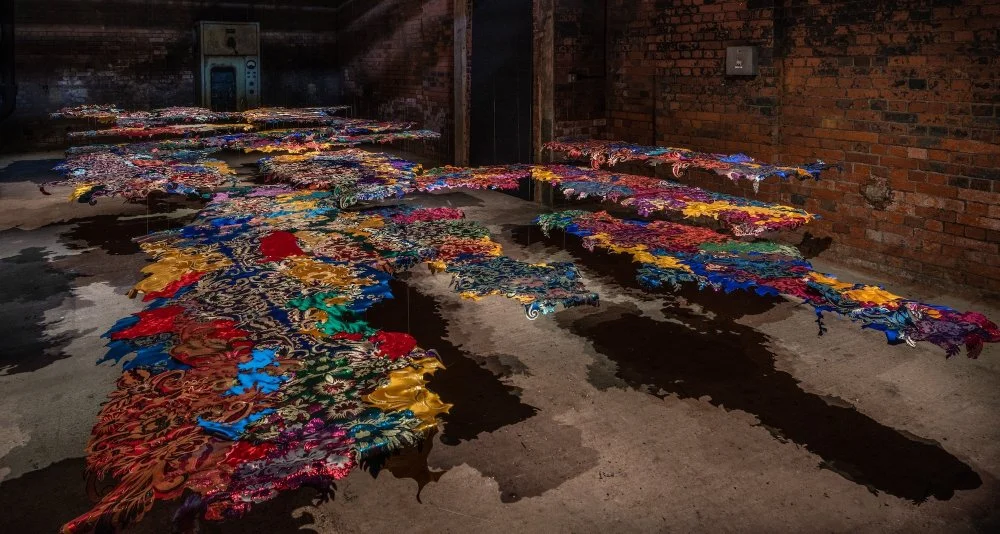
Moment of the Present, 2018 Installation: wood, brocade, lurex and pins. «Focus Kazakhstan: Post-Nomadic Mind», Wapping Project, London, 2018/Aspan gallery
‘I Speak of Ancestral Traumas Passed Down from Generation to Generation’
In 2022–2023, during an art residency in Hong Kong, Mukazhanova created two large felt and fabric canvases depicting the ‘dialogue and resistance between the Chinese and Kazakh cultures’. The ‘Kazakh’ canvas was brought to Almaty for an exhibition that didn’t ultimately take place. However, Meruert Kaliyeva, the curator and director of Aspan Gallery, was determined to showcase such a striking work.
‘A few years ago, I had already touched the theme of the horizon line,’ Gulnur Mukazhanova explains. ‘The 16 meter canvas (the “Kazakh” piece) itself “asked” to continue being worked on. On one end of the canvas is a large surface of the color red. This is the champ, a symbol of an unfinished story. From there, I decided to extend the canvas. For me, it's the horizon line. In reality, it should be continuous, like the endless steppes. But now, I see the horizon as broken. That's why the canvas is interrupted by fragments of bare wall. This horizon represents our society in post-Soviet Kazakhstan. The country could already be standing on its own feet. Our culture could flourish, and our people could live with dignity, and not merely survive. But we have trampled on the honor of our ancestors and everything they left for us. The broken horizon line now symbolizes the fragmentation of society, unresolved past traumas, and today's fears.’

Gulnur Mukazhanova. Shadows of Hope: Yesterday’s Past, Today’s Present, 2022. Fine merino wool, felted by hand, textile, pins. Each: 150 x 1600 cm. Group show «Clouds, Power and Ornament - Roving Central Asia» at Centre for Heritage Arts & Textile, Hong Kong/courtesy of CHAT, Lusher Photography/Aspan gallery
The idea of the ‘broken horizon’ seemingly implies a distant perspective, inviting the viewer to take in the entire canvas at once. However, the gallery space, the nature of the image, and the artist’s method contradict this spectatorial approach. The Aspan Gallery, divided by columns in the middle, is simply too small a space to be able to view the work in its entirety. Further, Ümıt Şuağy is essentially a vast lyrical abstraction. This type of non-objective canvas suggests immersion in the ‘paint’. The viewer should get very close to the artwork (ideally so that nothing but the image is in view) and meditate on it, allowing the patches of color to freely evoke thought and feeling. The abundance of details also compels visitors to come closer. Additionally, the canvas is very heterogeneous: the section created for the Hong Kong exhibition differs significantly from the later parts.
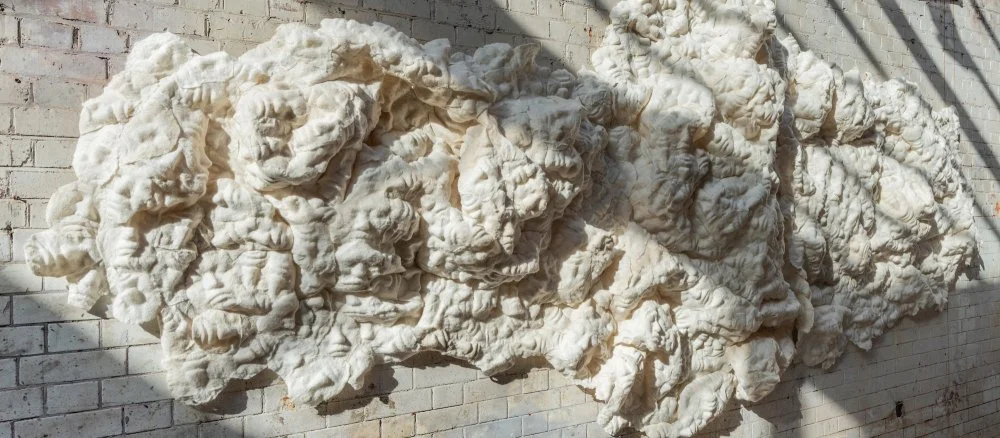
Gulnur Mukazhanova. Transformation of Traditional Values during Globalisation, 2018. Installation, wool, felt, mixed media, 1800 x 4000 cm. Wapping Project, London, 2018/Aspan gallery
All these factors encourage the viewer to examine the canvas in a gradual manner, moving slowly from the beginning to its end. The artist herself employed a methodical, sequential approach, adding fragment after fragment using the felting technique. This process mirrors the theme of her work, which addresses Kazakhstan’s development during the period of its independence, an ongoing and gradual transformation in itself. Mukazhanova’s installation can be compared to a musical composition, where instead of sound, color, patches, texture, and rhythm take centre stage.
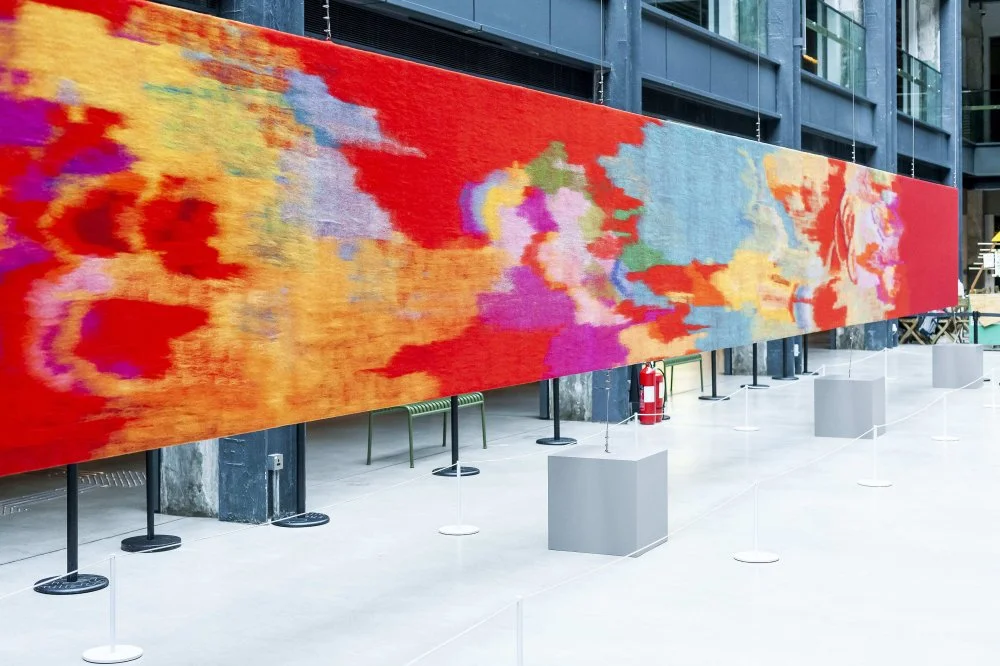
Gulnur Mukazhanova. Shadows of Hope: Yesterday’s Past, Today’s Present, 2022. Fine merino wool, felted by hand, textile, pins. Each: 150 x 1600 cm. Group show «Clouds, Power and Ornament - Roving Central Asia» at Centre for Heritage Arts & Textile, Hong Kong/CHAT, Lusher Photography/Aspan gallery
Observers need to resist the temptation to view Ümıt Şuağy from left to right as one might typically do. The installation begins with the right wall, where a continuous 16-meter canvas from the artist’s Hong Kong residency hangs. The abundance of rounded elements, seemingly floating freely against a red background, the successful color combinations, and the smooth, calm rhythm combined with the energy of the color evoke associations with some of Kandinsky's works from the 1910s. The artwork also recalls his view of art as a natural, internally harmonious ‘microcosm’. This balanced, organic part of the composition can be interpreted as a space of dreams: a potential, so to speak, Kazakhstan, a ‘beautiful Kazakhstan of the future’, as was envisioned immediately after gaining independence.
The other part of the canvas, in contrast, conveys the air and atmosphere of post-Soviet society. Here, the scenes change. The breaks in the ‘horizon’ create unsettling pauses of silence, as if a melody has been interrupted by the interference of a chewed-up film. And memories of Kandinsky seem out of place here. Instead, a range of associations with more dramatic expressionist artists emerge, such as Emil Nolde (with his semi-abstract landscapes) and, in some areas, Edvard Munch.
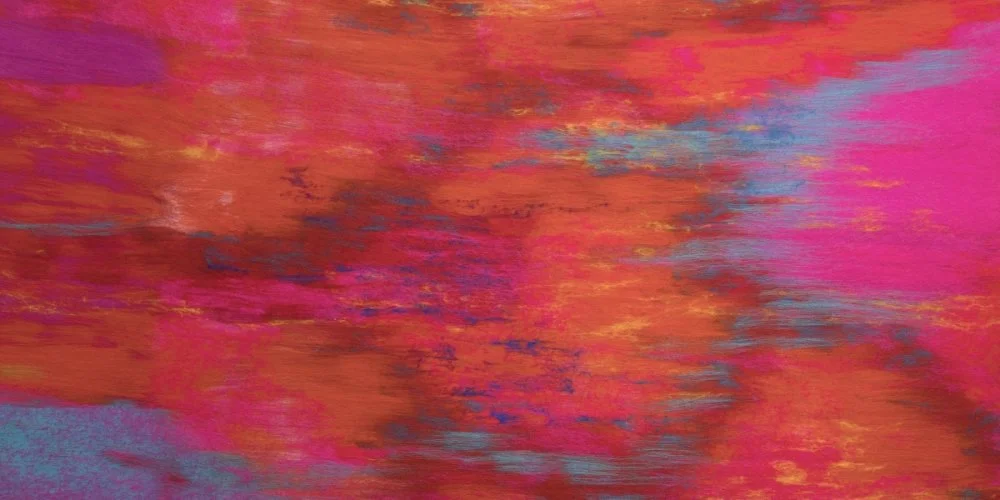
Gulnur Mukazhanova “Shadows of Hope #3”, 2024 Fine merino wool 150 x 170 cm/Aspan gallery
The contrasting color combinations are deliberately disharmonious. The colors seem unable to ‘blend’ with one another. A glaring brightness is followed immediately by a pale, smoky fragment, as if pieces from entirely different works were carelessly stitched together. The compositions lack balance. The patches, more dynamic and shapeless, resemble expressionist brushstrokes, often with ‘torn’ edges. The fragmented nature of the image creates a sense of chaos and confusion. As the installation progresses, these ‘contradictions’ only intensify, and the viewer’s anxiety grows. The canvas experiences more frequent ‘tears’, and the aspirations and hopes from the first part appear as separate flashes, turning into ghosts that seem neither fully dissipated nor able to find a foundation to materialize.
The final section of the installation is a wide tear, a canvas seemingly hung apart from the others, dominated by black, a color the artist usually avoids. Gulnur Mukazhanova explains: ‘At the end of working on this piece, I consciously decided to use black, trying to confront my fear. When you confront your fear, it starts to release you. At first, I wanted the finale to be impenetrably black, but I tried to soften it with bright shades because confronting fear is hard. I speak of ancestral traumas passed down from generation to generation, which manifest themselves in our daily lives and personal situations. We are often told to ‘Be silent!’ I heard this from my grandmother, from my mother, and from other relatives. This is the fear we continue to live with. And even now, it controls people.’
Finally, Ümıt Şuağy is a spiritual panorama of post-Soviet Kazakhstan. It tells the story of how the independence Kazakhstan gained was, in many ways, only superficial. The fall of the Bolshevik regime and the collapse of the Soviet Empire were merely the first steps on the path to true independence. The model of relations between the state and its ‘subjects’ remained unchanged. The new values proclaimed from the tribunes by the authorities fueled ‘great hopes’, but in essence, they were nothing more than a freshly painted facade hiding the same old authoritarian hierarchy. Hope, like fear, becomes a psychological tool for maintaining control that is easily drawn from the subconscious of post-Soviet citizens.
Fear breeds distrust, which, in its turn, fractures and divides society. This creates an atmosphere of daily ‘war of all against all’, where everyone works for themselves only, and there is little trust in others. Erbosyn Meldibekov captured this state of affairs brilliantly in his photo ‘My Brother—My Enemy’ and later in his sculpture Goodbye, Brother! Gulnur's anxious fragmentation and broken horizon convey the same idea. The ‘breaks’, like moments of silence in the composition, serve as a metaphor for the inability to engage in dialogue, which is vital for a society capable of defending its interests.
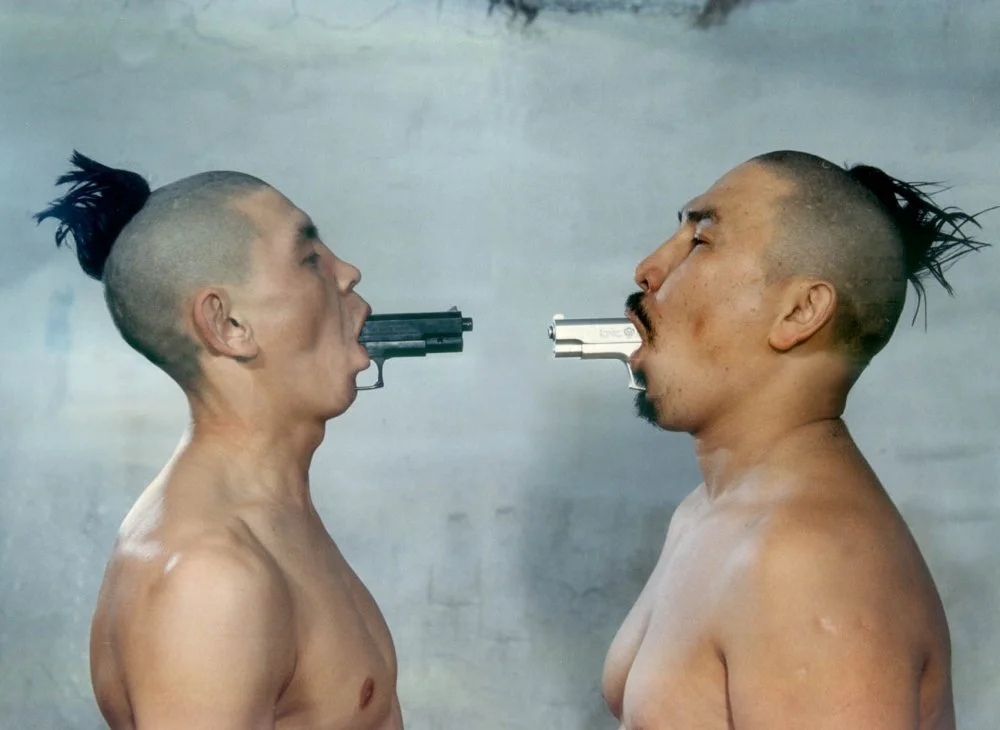
Yerbossyn Meldibekov My Brother, My Enemy, 2002 C-print 70 x 100 cm Edition of five/Aspan gallery
The final canvas of Ümıt Şuağy illustrates that real change cannot be expected for as long as the old and typically authoritarian models dominate our society (especially on a personal level). The twentieth century, although over, has not entirely receded into the past. Its ghosts still hover in the stifling air of post-Soviet space. This brilliant artist suggests that real renewal can only happen in a ‘patchwork’ process: within individual people, families, and communities that re-examine and transform their models of perception and relationships. Of course, this is not a quick process, but as we know, hope dies last. And even its shadow surprisingly perseveres.
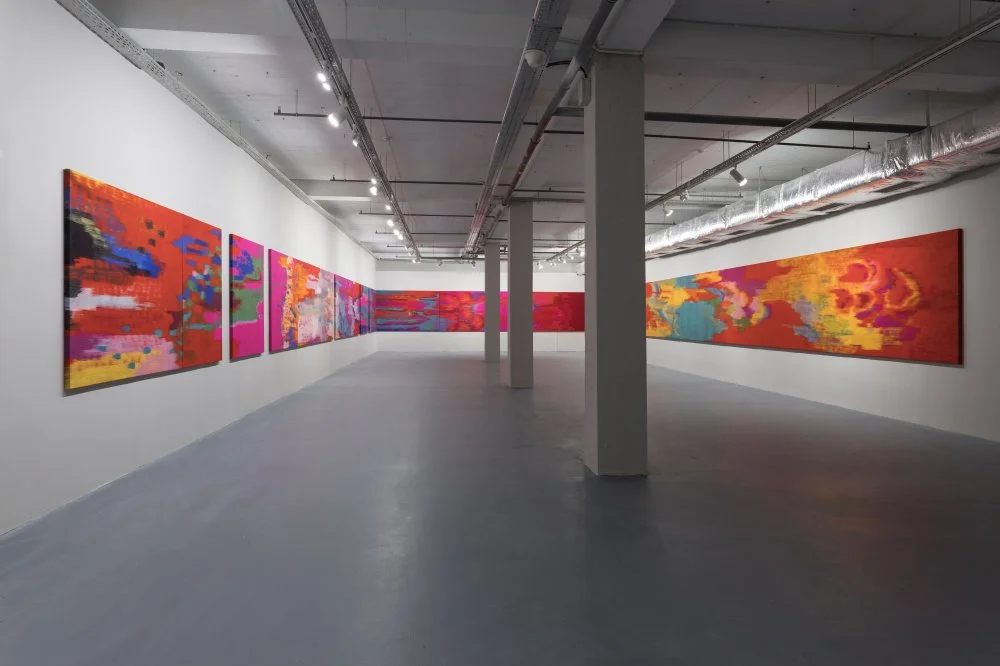
“Shadows of Hope” Installation view/Aspan gallery
